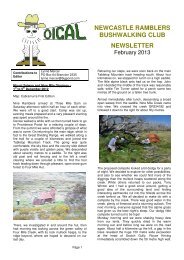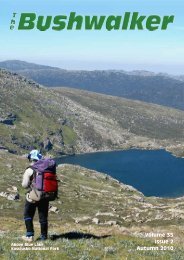Cold Weather Clothing - University of Manitoba
Cold Weather Clothing - University of Manitoba
Cold Weather Clothing - University of Manitoba
- No tags were found...
You also want an ePaper? Increase the reach of your titles
YUMPU automatically turns print PDFs into web optimized ePapers that Google loves.
BodyInsulationBodyInsulationBodyInsulationGortexWarmHotEvapHotEvapTDewTDewTDewFigure 3 indicates some strategies to minimize moisture accumulation within clothing.Left Panel – Multiple layering increases the chance that the temperature reaches the DewPoint somewhere between clothing layers. Thus if moisture condenses and freezesbetween the layers, ice can be brushed <strong>of</strong> from the material surfaces instead <strong>of</strong> beingtrapped with the material itself.Center Panel – Heavy work will increase the skin surface temperature. The newtemperature pr<strong>of</strong>ile (dark line) shows that the Dew Point occurs past the outside layer<strong>of</strong> the clothing instead <strong>of</strong> within the material, as would have occurred with a lowerinitial skin temperature (light line).Right Panel – This shows that an increased skin temperature is required to allow the forcing<strong>of</strong> moisture vapor through the “liquid-resistant, vapor-permeable” surface materialbefore it condenses and evaoprates or freezes.Based on these principles, it is advisable that the outer shell should not be combined withthe insulation. Therefore if condensation and freezing does occur on the inside <strong>of</strong> theouter layer it can be brushed <strong>of</strong>f.CONCLUSIONRemember the following points and you will go a long way to ensuring comfortablesafe clothing use in the harsh cold climate:1) THERE IS NO SUCH THING AS BAD WEATHER… ONLY BAD CLOTHING.2) As much as possible, the clothing ensemble should be designed for thespecific conditions to be encountered.3) You can widen the window <strong>of</strong> conditions in which a specific clothingensemble can be used, even though they are outside the parameters that theensemble was originally designed for.4) KEEP WATER MOLECULES OUT OF THE CLOTHING ENSEMBLE !!!!!This requires commitment to:a) Proactive layering changes,b) Aggressive clothing ventilation to expel moisture during the day,c) Continued efforts to remove moisture at the end <strong>of</strong> the day.<strong>Cold</strong> <strong>Weather</strong> <strong>Clothing</strong> 7 Gordon Giesbrecht
















